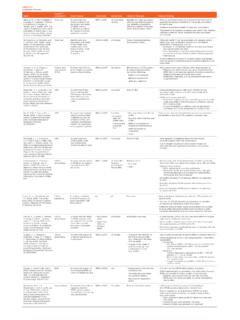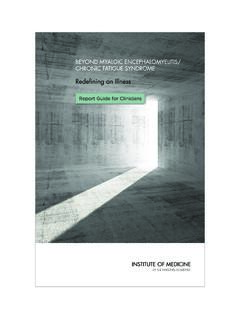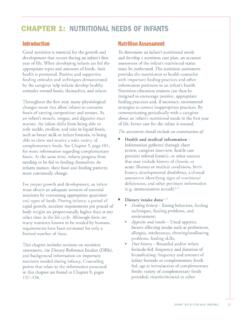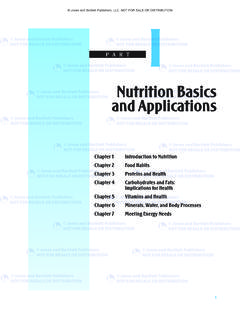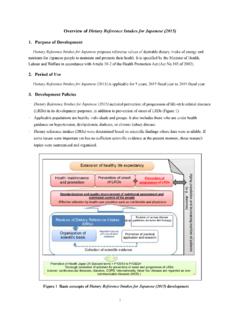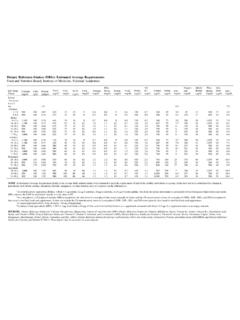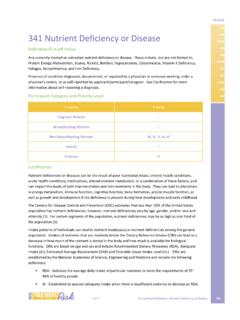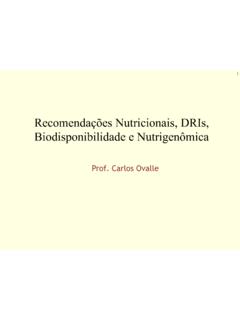Transcription of Dietary Reference Intakes for Sodium and Potassium
1 Consensus Study Report March 2019 HIGHLIGHTS. Dietary Reference Intakes for Sodium and Potassium Potassium and Sodium are interrelated, essential nutrients that play vital roles in the body to maintain physiological homeostasis. Both nutrients have been linked to risk of chronic disease, particularly cardiovascular disease. Additionally, a possible association of Sodium intake with other adverse health outcomes has been suggested. The coexistence of essen- tiality with a relationship to adverse health effects, including chronic disease, called for a new approach to establishing intake recommen- dations for Potassium and Sodium within the context of the Dietary Reference Intakes (DRIs). The DRIs are a set of Reference values developed jointly for the United States and Canada by the National Academies of Sciences, Engineering, and Medicine. The DRI model, which was developed in recognition of the need for a safe and adequate range of Intakes , had intended that evidence on chronic disease risk be incorporated in the process.
2 How- ever, relationships between nutrient Intakes and chronic disease risk, in particular, are often more complex than the relationships observed for adequacy and toxicity effects. Using evidence on chronic disease risk in the DRI model proved to be challenging. To overcome methodological limitations, guidance for expanding the DRI. model to include a new category of values specific to chronic disease risk reduction was provided in the 2017 National Academies report, Guiding Principles for Developing Dietary Reference Intakes Based on Chronic Disease (the Guiding Principles Report). In this new report, Dietary Reference Intakes for Sodium and Potassium , a National Academies committee reviews the current evidence and updates the DRIs for Potassium and Sodium that were established in 2005. The committee also applies recommendations from the Guiding Principles Report for establishing a new category of DRIs based on chronic disease, called the Chronic Disease Risk Reduction Intakes (CDRRs).
3 Dietary Reference Intakes FOR Potassium with hypertension, a Potassium CDRR cannot be established There remains insufficient evidence to establish Potassium because of unexplained inconsistency in the body of evi- DRIs for adequacy as estimated Average Requirements (EARs) dence, a lack of intake response relationship, and limited and Recommended Dietary Allowances (RDAs). There also evidence for relationships between Potassium intake and remains insufficient evidence to establish Potassium DRIs for chronic disease endpoints. toxicity as Upper Tolerable intake Levels (ULs). As with all AIs, the Potassium AIs are the best estimates for In the absence of a specific indicator of Potassium adequacy, an intake level in apparently healthy individuals, rather than the Potassium Adequate Intakes (AIs) are established using estimates of Potassium requirements. The lack of a Potassium the highest median Potassium intake across two nationally CDRR does not imply a lack of an effect of Potassium intake representative surveys for each DRI group in children and for on chronic disease, but rather a lack of evidence to charac- adult males and females.
4 The median Intakes that informed terize the effect. Similarly, the absence of a UL for Potassium the Potassium AIs for adults are from males and females with does not mean that there is no risk from excessive intake , normal blood pressure and without a self-reported history of either overall or for segments of the population. Caution cardiovascular disease. For infants, the AIs are derived from against high intake through supplemental Potassium is war- estimates of Potassium Intakes in breastfed infants. ranted for certain population groups, particularly those with or at high risk for compromised kidney function. Despite moderately strong evidence that Potassium supple- mentation reduces blood pressure, particularly among adults The Potassium DRIs are presented in Table 1 below. TABLE 1: Potassium Dietary Reference Intakes , BY AGE, SEX, AND LIFE-STAGE GROUP. Life-Stage Group AI (mg/d) UL CDRR. Infants 0 6 months 400 NDb NDc 7 12 months 860 NDb NDc Children 1 3 years 2,000a NDb NDc 4 8 years 2,300a NDb NDc Males 9 13 years 2,500a NDb NDc 14 18 years 3,000a NDb NDc 19 30 years 3,400a NDb NDc 31 50 years 3,400a NDb NDc 51-70 years 3,400a NDb NDc >70 years 3,400a NDb NDc Females 9 13 years 2,300a NDb NDc 14 18 years 2,300a NDb NDc 19 30 years 2,600a NDb NDc 31 50 years 2,600a NDb NDc 51 70 years 2,600a NDb NDc >70 years 2,600a NDb NDc Pregnancy 14 18 years 2,600a NDb NDc 19 30 years 2,900a NDb NDc 31 50 years 2,900a NDb NDc Lactation 14 18 years 2,500a NDb NDc 19 30 years 2,800a NDb NDc 31 50 years 2,800a NDb NDc NOTES: AI = Adequate intake ; CDRR = Chronic Disease Risk Reduction intake ; ND = not determined; UL =Tolerable Upper intake Level.
5 A Updated DRI value, as compared to the 2005 DRI Report. b Not determined owing to lack of a toxicological indicator specific to excessive Potassium intake . c Not determined owing to insufficient strength of evidence for causality and intake response. Dietary Reference Intakes FOR Sodium CDRR is established using evidence of the beneficial effect of There remains insufficient evidence to establish Sodium DRIs reducing Sodium intake on cardiovascular disease risk, hyper- for adequacy as EARs and RDAs. Furthermore, there is insuffi- tension risk, systolic blood pressure, and diastolic blood pres- cient evidence to establish a toxicological risk level from high sure. Reduction of Sodium Intakes above the Sodium CDRR is Sodium intake , separate from chronic disease risk. As such, expected to reduce chronic disease risk within the apparently no Sodium UL is established. healthy population. In the absence of a specific indicator of Sodium adequacy, the Most and Canadian population groups consume Sodium Sodium AI for adults is based on the lowest levels of Sodium above both the AI and CDRR levels.
6 There is no concern of Intakes evaluated in randomized controlled trials for which Sodium inadequacy in the population. Intakes above the there was no evidence of deficiency and also drew on evidence CDRR increase the risk of chronic disease in the population. from the best-designed balance study. There is insufficient Reducing Sodium intake has a greater effect on adults with evidence from observational studies that there are harmful hypertension than on adults with normal blood pressure, but effects from low Sodium intake . The Sodium AIs for children the benefits of reducing Sodium intake toward the Sodium are extrapolated from the adult values based on estimated CDRR apply to both groups. There is evidence that reducing Energy Requirements. For infants, the AIs are derived from Sodium intake below the CDRR can lower systolic and diastolic estimates of Sodium Intakes in breastfed infants. blood pressure, but the effect on chronic disease risk cannot be characterized at this time.
7 There is sufficient evidence to characterize the relationship between Sodium intake and risk of chronic disease. The The Sodium DRIs are presented in Table 2 below. TABLE 2: Sodium Dietary Reference Intakes , BY AGE, SEX, AND LIFE-STAGE GROUP. Life-Stage Group AI (mg/d) UL CDRR. Infants 0 6 months 110a NDb NDc 7 12 months 370 NDb NDc Children 1 3 years 800a NDb Reduce Intakes if above 1,200 mg/dayd 4 8 years 1,000a NDb Reduce Intakes if above 1,500 mg/dayd Males 9 13 years 1,200a NDb Reduce Intakes if above 1,800 mg/dayd 14 18 years 1,500 NDb Reduce Intakes if above 2,300 mg/dayd 19 30 years 1,500 NDb Reduce Intakes if above 2,300 mg/day 31 50 years 1,500 NDb Reduce Intakes if above 2,300 mg/day 51 70 years 1,500a NDb Reduce Intakes if above 2,300 mg/day >70 years 1,500a NDb Reduce Intakes if above 2,300 mg/day Females 9 13 years 1,200a NDb Reduce Intakes if above 1,800 mg/dayd 14 18 years 1,500 NDb Reduce Intakes if above 2,300 mg/dayd 19 30 years 1,500 NDb Reduce Intakes if above 2,300 mg/day 31 50 years 1,500 NDb Reduce Intakes if above 2,300 mg/day 51 70 years 1,500a NDb Reduce Intakes if above 2,300 mg/day >70 years 1,500a NDb Reduce Intakes if above 2,300 mg/day Pregnancy 14 18 years 1.
8 500 NDb Reduce Intakes if above 2,300 mg/dayd 19 30 years 1,500 NDb Reduce Intakes if above 2,300 mg/day 31 50 years 1,500 NDb Reduce Intakes if above 2,300 mg/day Lactation 14 18 years 1,500 NDb Reduce Intakes if above 2,300 mg/dayd 19 30 years 1,500 NDb Reduce Intakes if above 2,300 mg/day 31 50 years 1,500 NDb Reduce Intakes if above 2,300 mg/day NOTES: AI = Adequate intake ; CDRR = Chronic Disease Risk Reduction intake ; ND = not determined; UL =Tolerable Upper intake Level. a Updated DRI value, as compared to the 2005 DRI Report. b Not determined owing to lack of a toxicological indicator specific to excessive Sodium intake . c Not determined owing to insufficient strength of evidence for causality and intake response. d Extrapolated from the adult CDRR based on sedentary estimated Energy Requirements. Committee to Review the Dietary Reference Intakes for Sodium and Potassium FUTURE DIRECTIONS. Virginia A. Stallings Jiang He The committee identifies a number of research needs (Chair) Tulane University School of that will help inform future Potassium and Sodium University of Pennsylvania Public Health and Tropical DRIs.
9 For example, methods for assessing potas- Perelman School of Medicine Medicine and Children's Hospital of sium and Sodium intake need to be strengthened to Joachim H. Ix Philadelphia University of California San improve accuracy. Additional research is needed to Cheryl A. M. Anderson Diego School of Medicine identify requirements for both nutrients and to better University of California, Alice H. Lichtenstein characterize negative health effects from high intake San Diego (until September 2018). Tufts University levels. Future trials that assess the long-term effects Joseph V. Rodricks of different doses and forms of Potassium are needed Patsy M. Brannon Ramboll Environ to characterize the intake response relationship Cornell University Janet A. Tooze with blood pressure and chronic disease outcomes. Alicia Carriquiry Wake Forest School of Medicine Iowa State University Research providing additional insight into population George A. Wells Weihsueh Chiu University of Ottawa Heart groups with differing responses to Sodium intake Texas A&M University would benefit future updates to the Sodium CDRR.
10 Institute Nancy R. Cook Elizabeth A. Yetley Furthermore, additional research is needed on the Brigham and Women's Hospital and Harvard Medical School National Institutes of Health interrelationship between Potassium and Sodium (retired) Intakes . With the vast majority of and Canadian Eric A. Decker University of Massachusetts populations consuming Sodium at levels above the Amherst CDRR, opportunities exist to find novel solutions to reduce population Sodium Intakes . Finally, as experi- Study Staff ence is gained with using the expanded DRI model, there will likely be continued enhancement of the Meghan Harrison Meredith Young Study Director Senior Program Assistant process and a need for additional guidance on the proper applications of the Reference values. Maria Oria Ann L. Yaktine Senior Program Officer Director, Food and Nutrition Board Anna Bury Research Associate (until August 2018). Alice Vorosmarti Research Associate (from August 2018).





